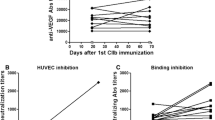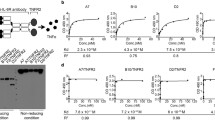Abstract
Extensive angiogenesis in the synoviums is a characteristic pathology of rheumatoid arthritis (RA). We have demonstrated that anti-flt-1 hexapeptide, GNQWFI, specifically inhibits the interaction of VEGF or PlGF with its receptor flt-1 (Yoo et al. [13]). In this study, we investigate the feasibility of the synthetic D-form of anti-flt-1 hexapeptide conjugated with 8-amino-3,6-dioxaoctanoic acid (mini-PEG™) for treatment of RA. We first modified the structure of anti-flt-1 peptide from the L-form (GNQWFI) to all D-form (gnqwfi; allD) and then conjugated allD with mini-PEG™ to enhance its stability. The result showed that the allD anti-flt-1 peptide showed an increased stability in the sera without major loss of inhibitory activity. The allD and its mini-PEGylated derivative similarly suppressed wounding migration, chemotaxis, and tube formation of endothelial cells in vitro. However, in the Matrigels assay, the in vivo anti-angiogenic activity of mini-PEGylated allD was stronger than that of native allD or L-form. Moreover, oral and subcutaneous administration of mini-PEGylated allD, but not oral feeding of original L-form, successfully suppressed severity of collagen-induced arthritis. After a single subcutaneous injection, the Cy5-labeled mini-PEGylated allD was found to be distributed systemically and accumulated in arthritic joints of mice, particularly in joints with a severe clinical score. In conclusion, our data suggests that mini-PEGylated allD is more beneficial in the treatment of RA than unmodified anti-flt-1 peptides, since it has increased stability and the possibility of oral delivery, and could be applied to treat angiogenesis-dependent human diseases, including RA.






Similar content being viewed by others
References
Feldmann M, Brennan FM, Maini RN (1996) Rheumatoid arthritis. Cell 85:307–310
Koch AE (1998) Angiogenesis: implications for rheumatoid arthritis. Arthritis Rheum 41:951–962
Szekanecz Z, Gaspar L, Koch AE (2005) Angiogenesis in rheumatoid arthritis. Front Biosci 10:1739–1753
Fava RA, Olsen NJ, Spencer-Green G et al (1994) Vascular permeability factor/endothelial growth factor: accumulation and expression in human synovial fluids and rheumatoid synovial tissue. J Exp Med 180:341–346
Lee SS, Joo YS, Kim WU et al (2001) Vascular endothelial growth factor levels in the serum and synovial fluid of patients with rheumatoid arthritis. Clin Exp Rheumatol 19:321–324
Ferrara N, Hillan KJ, Gerber HP, Novotny W (2004) Discovery and development of bevacizumab, an anti-VEGF antibody for treating cancer. Nat Rev Drug Discov 3:391–400
Yang JC, Haworth L, Sherry RM et al (2003) A randomized trial of bevacizumab, an anti-vascular endothelial growth factor antibody, for metastatic renal cancer. N Engl J Med 349:427–434
Bashshur ZF, Bazarbachi A, Schakal A, Haddad ZA, El Haibi CP, Noureddin BN (2006) Intravitreal bevacizumab for the management of choroidal neovascularization in age-related macular degeneration. Am J Ophthalmol 142:1–149
Kiselyov A, Balakin KV, Tkachenko SE (2007) VEGF/VEGFR signalling as a target for inhibiting angiogenesis. Expert Opin Investig Drugs 16:83–107
Bae DG, Gho YS, Yoon WH, Chae CB (2000) Arginine-rich anti-vascular endothelial growth factor peptides inhibit tumor growth and metastasis by blocking angiogenesis. J Biol Chem 275:13588–13596
Yoo SA, Bae DG, Ryoo JW et al (2005) Arginine-rich anti-vascular endothelial growth factor (anti-VEGF) hexapeptide inhibits collagen-induced arthritis and VEGF-stimulated productions of TNF-α and IL-6 by human monocytes. J Immunol 174:5846–5855
Bae DG, Kim TD, Li G, Yoon WH, Chae CB (2005) Anti-flt1 peptide, a vascular endothelial growth factor receptor 1-specific hexapeptide, inhibits tumor growth and metastasis. Clin Cancer Res 11:2651–2661
Yoo SA, Yoon HJ, Kim HS et al (2009) Role of placenta growth factor and its receptor flt-1 in rheumatoid inflammation: a link between angiogenesis and inflammation. Arthritis Rheum 60:345–354
Woodley JF (1994) Enzymatic barriers for GI peptide, protein delivery. Crit Rev Ther Drug Carr Syst 11:61–95
Goldberg M, Gomez-Orellana I (2003) Challenges for the oral delivery of macromolecules. Nat Rev Drug Discov 2:289–295
Kong JS, Yoo SA, Kim JW et al (2010) Anti-neuropilin-1 peptide inhibition of synoviocyte survival, angiogenesis, and experimental arthritis. Arthritis Rheum 62:179–190
Neufeld G, Cohen T, Gengrinovitch S, Poltorak Z (1999) Vascular endothelial growth factor (VEGF) and its receptors. FASEB J 13:9–22
Philipsen EK, Batsberg W, Christensen AB (1988) Gastrointestinal permeability to poly(ethylene glycol): an evaluation of urinary recovery of an oral load of poly(ethylene glycol) as a parameter of intestinal permeability in man. Eur J Clin Invest 18:139–145
Ma TY, Hollander D, Krugliak P, Katz K (1990) PEG 400, a hydrophilic molecular probe for measuring intestinal permeability. Gastroenterology 98:39–46
Ramanathan S, Qiu B, Pooyan S et al (2001) Targeted PEG-based bioconjugates enhance the cellular uptake and transport of a HIV-1 TAT nonapeptide. J Control Release 77:199–212
Calceti P, Salmaso S, Walker G, Bernkop-Schnürch A (2004) Development and in vivo evaluation of an oral insulin-PEG delivery system. Eur J Pharm Sci 22:315–323
Li H, Song JH, Park JS, Han K (2003) Polyethylene glycol-coated liposomes for oral delivery of recombinant human epidermal growth factor. Int J Pharm 258:11–19
Fischer PM (2003) The design, synthesis and application of stereochemical and directional peptide isomers: a critical review. Curr Protein Pept Sci 4:339–356
Fauchere JL, Thurieau C (1992) Evaluation of the stability of peptides and pseudopeptides as a tool in peptide drug design. Adv Drug Res 23:127–159
Hong SY, Oh JE, Lee KH (1999) Effect of D-amino acid substitution on the stability, the secondary structure, and the activity of membrane-active peptide. Biochem Pharmacol 58:1775–1780
Murakami M, Iwai S, Hiratsuka S et al (2006) Signaling of vascular endothelial growth factor receptor-1 tyrosine kinase promotes rheumatoid arthritis through activation of monocytes/macrophages. Blood 108:1849–1856
Luttun A, Tjwa M, Moons L et al (2002) Revascularization of ischemic tissues by PlGF treatment, and inhibition of tumor angiogenesis, arthritis and atherosclerosis by anti-Flt1. Nat Med 8:831–840
Afuwape AO, Feldmann M, Paleolog EM (2003) Adenoviral delivery of soluble VEGF receptor 1 (sFlt-1) abrogates disease activity in murine collagen-induced arthritis. Gene Ther 10:1950–1960
Morishita M, Peppas NA (2006) Is the oral route possible for peptide and protein drug delivery? Drug Discov Today 11:905–910
Acknowledgments
We thank all the members of the Institute of Bone and Joint Diseases at the Catholic University of Korea. This work was supported by grants from the Korea Healthcare technology R&D Project, Ministry for Health, Welfare and Family Affairs (No. A092258 and No. A084948), and National Research Foundation of Korea (NRF) funded by the Ministry of Education, Science and Technology (R33-2008-000-10064-0 and 2009-0080087).
Author information
Authors and Affiliations
Corresponding author
Additional information
Jin-Sun Kong and Seung-Ah Yoo contributed equally to this work.
Electronic supplementary material
Below is the link to the electronic supplementary material.
Rights and permissions
About this article
Cite this article
Kong, JS., Yoo, SA., Kang, JH. et al. Suppression of neovascularization and experimental arthritis by D-form of anti-flt-1 peptide conjugated with mini-PEG™ . Angiogenesis 14, 431–442 (2011). https://doi.org/10.1007/s10456-011-9226-0
Received:
Accepted:
Published:
Issue Date:
DOI: https://doi.org/10.1007/s10456-011-9226-0




